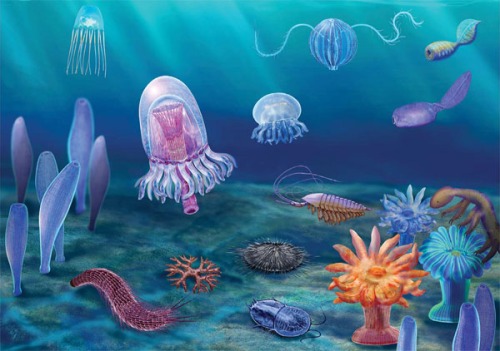The base of the Cambrian has long been defined as the level where abundant shelly fossils and most phyla first occur in the stratigraphic record. That increase in diversity led to the nickname ‘Cambrian Explosion’, despite the fact that sheer numbers and diversity of lesser taxa took a long time to rise to ‘revolutionary’ levels. Yet a great deal of animal evolution was going on during the preceding Proterozoic Era that was revealed once palaeobiological research blossomed in rocks of that age range. Today, the earliest occurrences, or at least hints, of quite a few phyla can be traced to the last 100 Ma of the Precambrian. Clearly, the Cambrian Explosion needs a fresh look now that so many data are in. Any palaeontologist would benefit from reading a Perspective article in the latest issue of Nature Ecology & Evolution (Wood, R. and 8 others 2019. Integrated records of environmental change and evolution challenge the Cambrian Explosion. Nature Ecology & Evolution, v. 3, online publication; DOI: 10.1038/s41559-019-0821-6)
Rachel Wood of Edinburgh University and co-authors working elsewhere in Britain, Canada, Japan and Finland sift the growing wealth of fossil and trace-fossil evidence that predate the start of the Cambrian. They also consider the geochemical events that stand out in the Ediacaran Period that succeeds the Snowball Earth events of the Cryogenian. Their account recognises that the geochemical changes – principally a series of carbon-isotope (δ13C) excursions – may have resulted from tectonic changes. The carbon-isotope data mark a series of short-lived penetrations of oxygen-rich conditions deep into the ocean water column and longer periods of oxygen-starved deep water. Such perturbations in oceanic redox conditions ‘speed-up’ thorough the late-Ediacaran into the Cambrian: a profound and protracted transition from the Neoproterozoic world to that of the Phanerozoic. Over the same time span there is a ‘progressive addition of biological novelty’ in the form and function of the evolving biota, so that each successive assemblage builds on the earlier advances.
The fossil evidence suggests that the earliest Ediacaran fauna was metazoan but with no sign of bilaterian affinities (i.e. having ‘heads’ and ‘tails’). The rise of bilaterians of which most animal phyla are members occupied the later Ediacaran , with the first evidence of locomotion – and almost by definition animals with ‘fore’ and ‘aft’ – being around 560 Ma. Each discrete shift from more to less oxic conditions in the oceans seems to have knocked-back animal life, the reverse being accompanied by diversification of survivors. Oxygenation at the very start of the Cambrian marked the beginnings of a diversification clearly manifested by animals capable of biomineralisation and the secretion of hard parts with clear patterns. Such ‘shelly faunas’ are present in the latest Ediacaran sediments but with a multiplicity of seemingly arbitrary forms, although trace fossils suggest soft-bodied animals did have definite morphological pattern.

Diorama of the Lower Cambrian Qingjiang fauna (Credit: Fu et al. 2019; Fig 4)
Adding yet more information to early metazoan history is the recently discovered Cambrian Qingjiang lagerstätte of Hubei Province in southern China dated at 518 Ma; similar in its exquisite preservation to the Burgess (508 Ma) and Chengjiang (518 Ma) biotas (Fu, D. and 14 others 2019. The Qingjiang biota—A Burgess Shale-type fossil Lagerstätte from the early Cambrian of South China. Science, v. 363, p. 1338-1342; DOI: 10.1126/science.aau8800). The two previously discovered Cambrian lagerstättes are notable for their very diverse arthropod and sponge faunas. That at Qingjiang adds an abundance of cnidarians, jellyfish, sea anemones, corals and comb jellies, rare in the other two biotas, plus kinorhynchs or mud dragons – moulting invertebrates known only from Cambrian and modern sediments. The fossils at Qingjiang include only about 8% of the taxa of the same age found at Chengjiang, suggesting different environments
The idea of a sudden, discrete explosive event in the history of life, which coincided with the start of the Cambrian, now seems difficult to support. This should not damage the status of 541 Ma as the start of the Phanerozoic because stratigraphy basically gives form to the passage of time and has done since its emergence in the 19th century, so keeping the names of the divisions is essential to continuity.
Related articles: Daley, A.C. 2019. A treasure trove of Cambrian fossils. Science, v. 363, p. 1284-1285; DOI: 10.1126/science.aaw8644. Switek, B. 2019. Fossil Treasure Trove of Ancient Animals Unearthed in China (Smithsonian.com)
Read more on Palaeobiology

































































































